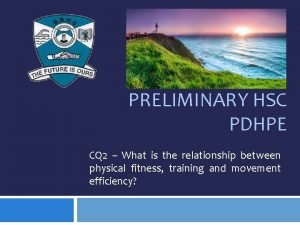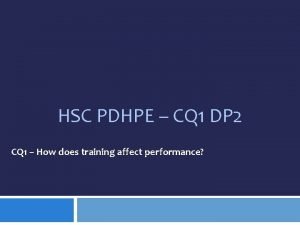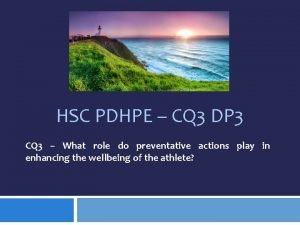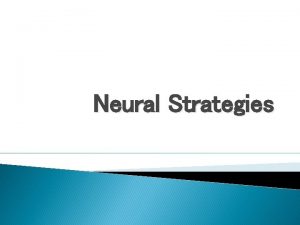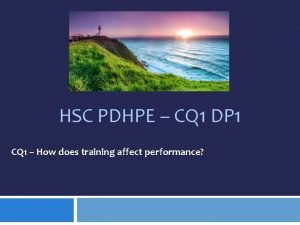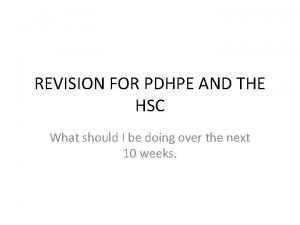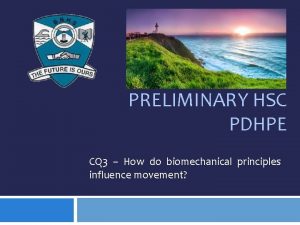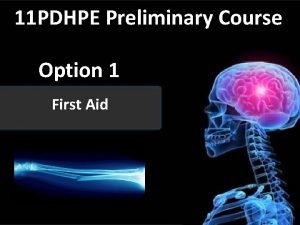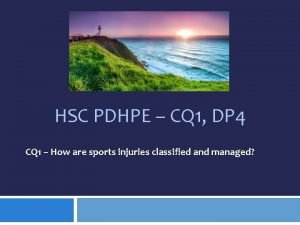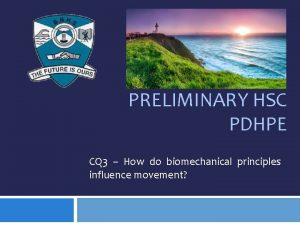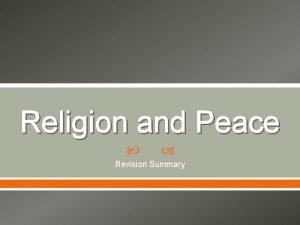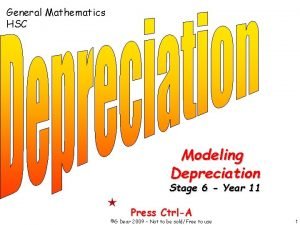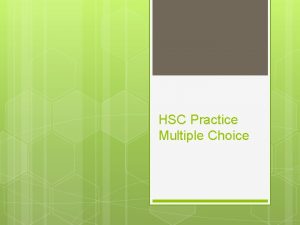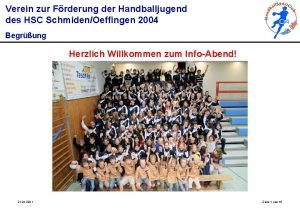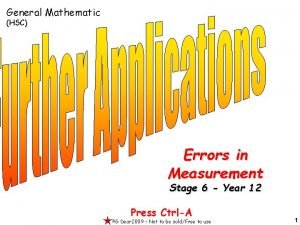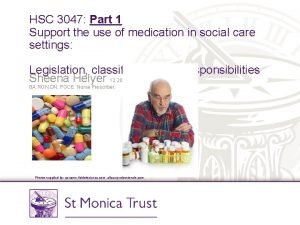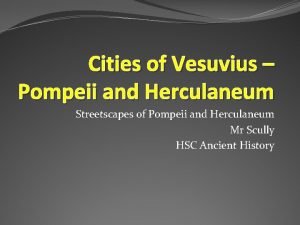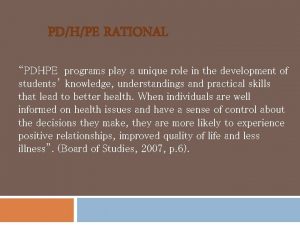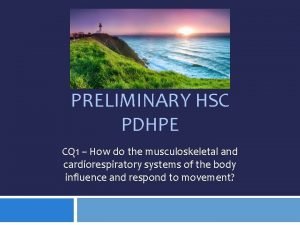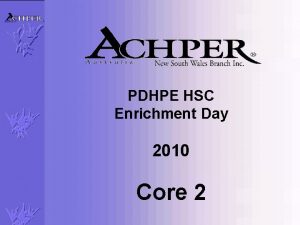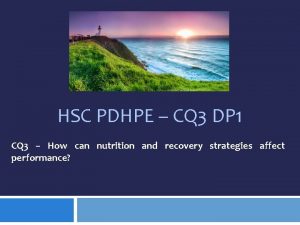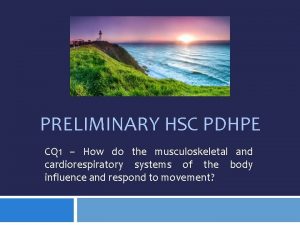HSC PDHPE CQ 4 DP 1 CQ 4
































- Slides: 32

HSC PDHPE – CQ 4 DP 1 CQ 4 – How is injury rehabilitation managed?

How is injury rehabilitation managed? Students learn about: Students learn to: • rehabilitation procedures – progressive mobilisation – graduated exercise (stretching, conditioning, total body fitness) – Training – use of heat and cold examine and justify rehabilitation procedures used for a range of specific injuries, eg hamstring tear, shoulder dislocation.

1. Rehabilitation procedures

1. rehabilitation procedures ü ü ü Rehabilitation after injury can take some time depending on the type and severity of the injury. A qualified doctor or physiotherapist should supervise the process. The aims of any rehabilitation program are to: restore optimal function of the injured area return the athlete to competition quickly and safely prevent re-injury.

Ø Progressive mobilisation

Ø Progressive mobilisation Any injury involving the muscular or connective tissues surrounding a joint will restrict movement of that joint. Joint mobilisation is the freeing of hindered joints to allow improved range of motion.

Ø Progressive mobilisation Joint mobilisation can be achieved through active exercises (performed by the athlete) or through passive methods (manipulation of the injured part by another person). Mobilisation of the injured part should begin soon after the injury because joint inactivity can increase the formation of scar tissue. The process is known as progressive mobilisation because the range of movement is gradually increased over time until the full range of movement is restored.

Ø Progressive mobilisation ü ü ü To ensure the safe mobilisation of injured body parts, the following precautions should be noted: Thorough checks should be made to ensure that there is no fracture at the site—an X- ray may be required. Mobilisation should not be commenced during the acute inflammatory phase. Circulation to the injured area should be increased before commencing mobilisation. The athlete should be relaxed before and during mobilisation. Movements should be slow and progressive, rather than sharp and rapid. Movements should remain within a pain-free range.

Ø graduated exercise (stretching, conditioning, total body fitness)

Ø graduated exercise Part of rehabilitation procedure involves the use of graduated exercise. This incorporates the use of stretching, conditioning and maintenance of total body fitness.

Ø graduated exercise (stretching) ü ü Loss of flexibility occurs as a result of injury to muscle and connective tissue, and the formation of scar tissue. A degree of flexibility will be returned to the site through progressive mobilisation. However, attention needs also to be paid to stretching exercises. If completed correctly, these will enhance rehabilitation by: reducing muscle tension increasing circulation increasing muscle and tendon length increasing the range of motion.

Ø graduated exercise (stretching) Flexibility, in common with mobilisation, is restored gradually to the injured area through the use of slow static stretches and proprioceptive neuromuscular facilitation (PNF) stretching early in the repair phase. The advantage of PNF stretching is that it does not require the injured site to be moved extensively. It also stimulates proprioceptors within the muscle and connective tissue. The stretching is gradually made more active, and is increased in time from 5– 10 seconds to 20– 30 seconds. Stretching should be performed regularly after a warm-up, and should always remain within the painfree range.

Ø graduated exercise (stretching) Passive stretching—with machines, a partner or a physiotherapist—is very common in sports rehabilitation. The purpose is to lengthen soft tissue beyond its normal resting length by applying an external force. The stretch should be held for approximately 15 seconds. The patient, physiotherapist or machine controls the direction, intensity and speed of the contraction. Passive stretches need to be explained and demonstrated carefully to ensure safety, and are good to use in a team setting.

Ø graduated exercise (conditioning) The restoration of muscular strength is essential in injury rehabilitation. Muscles that are active will increase in size and endurance whereas those that remain passive will decrease in size. Even if the area is immobilised (for example, in a cast or brace) a program should be designed to prevent muscle atrophy (wasting of muscle tissue). A program of isometric exercises can be used. These exercises involve no movement at the joints, but develop strength in the position exercised. This will prevent muscle atrophy until movement is possible.

Ø graduated exercise (conditioning) As swelling and pain lessen, exercises involving pain-free movement can be introduced. As strength is slowly regained, further resistance can be applied. The introduction of weight-bearing exercises can be considered if the injured area is thought to be capable of support. Isokinetic exercises are considered beneficial at this stage because they will develop strength through the full range of movement using uniform resistance. It is important to monitor the increase in strength of both the agonist muscles and antagonist muscles; that is, both the muscle being treated, and the muscle that moves in the opposite direction. This will ensure that an appropriate ratio of strength is being developed.

Ø graduated exercise (total body fitness) A program of rehabilitation involves not only the restoration of the injured part to full function, but also the maintenance of overall body fitness. With some injuries this can be a difficult task because the injury might require immobilisation. However, the maintenance of flexibility, strength and endurance should be promoted with activities that are specific to the sport or activity, and that do not endanger recovery from injury.

Ø graduated exercise (total body fitness) ü ü ü The choice of exercises to maintain total body fitness will depend on the type and severity of injury. Examples of activities that can be used to promote total body fitness during rehabilitation include: using treadmills using rowing or cycling ergometers swimming and water-resistance activities weight training walking or light jogging.

Ø training

Ø training An athlete who has finished a treatment and rehabilitation program is not ready to return to full competition. Even though the athlete might have a full active range of movement and flexibility, and even though the person’s strength might have returned to normal and total body fitness might have been maintained, the athlete is not ready for competition. If the athlete were to return to competition at this stage there would be a significant risk of re-injury because movement skills, specific game skills and confidence have not been re-established. Timing, speed and coordination are affected by rest from competition. In preparation for the physical and psychological demands of competition the athlete must undertake active training.

Ø training The final stages of rehabilitation involve developing muscle coordination and speed to full capacity. The athlete must be able to display skill proficiency equal to that of the athlete’s pre-injury performance standards, including the ability to delay fatigue and to perform required skills under pressure. An athlete who ‘favours’ the injured part (that is, attempts to protect it) increases the risk of reinjury to the site or a new injury to a different site.

Ø training Training before recommencement of competition must be aimed at re-establishing all skills in an environment that is as close as possible to competition conditions. Only when the athlete can display full fitness and coordinated movements and skills should he or she be permitted to resume competition. A graduated, progressive sport specific program will allow an athlete to develop the physical and psychological skills required for competition. Some athletes may be asked to play at a lower level prior to resuming at the level they were competing at prior to injury. � For example, an AFL player may play reserves prior to reentering the senior team. To determine their readiness to return, most athletes will undergo testing that is specific to their sport.

Ø use of heat and cold

Ø use of heat and cold Heat, cold, pressure and electrical stimulation are some of the modalities (forms of treatment) used in sports rehabilitation. These modalities are delivered by ice or by hot packs or by a number of machines, including ultrasound. Most modalities are used to break down the pain, muscle spasm and ischaemic (absent or reduced blood flow) responses of the body to an injury. In general, the choice of heat or cold modalities after the acute phase is dependent on the type of injury and, often, the patient’s preference.

Ø use of heat

Ø use of heat Heat modalities are used to increase circulation, either generally (in a large body area) or locally (at a given site). Superficial heating is heating to a depth of about 1 centimetre, whereas deep heating occurs to a depth of greater than 1 centimetre.

Ø use of heat ü ü ü ü The general physiological responses of the body to heat are: decreased pain increased ability to stretch relaxation increased blood flow reduced joint stiffness decreased muscle spasm enhanced inflammatory response (increased flow of blood/fluid to area) increased tissue healing.

Ø use of heat Heat is applied superficially via heat packs, hydrotherapy, infra-red lamps and contrast baths. Deep heat can be applied using ultrasound, shortwave and microwave machines. Heat should not be applied to acute injuries (i. e. when the injury just occurs).

Ø use of cold

Ø use of cold The application of ice to an injury is one of the most common cold modalities. The term used to describe the use of cold for treatment is ‘cryotherapy’. The most common ways of applying cryotherapy during rehabilitation are through the use of an ice pack (frozen gel), an ice bag (ice-filled plastic bag wrapped in a towel), an ice massage, ice immersion, a contrast bath (hot and cold) or a topical cold spray.

Ø use of cold ü ü These cold modalities are commonly used: in the acute phase of injury treatment after therapeutic exercise of injured sites. They reduce pain and swelling related to chronic and/or overuse injuries. Cold treatment also cools overheated participants.

Ø use of cold ü ü ü The application of cold to an injury site has the physiological effects of decreasing: swelling circulation to injured site acute inflammation pain and discomfort muscle spasm tissue metabolism.

Ø use of cold When used with rest, compression and elevation, cold treatment is especially effective in the treatment of swelling and pain associated with acute injuries. Stiffness is increased after cold treatment. Cold should be applied at regular intervals during the first 24– 48 hours of an injury, but not for longer than 30 minutes at a time. Care should be taken in the use of cryotherapy to avoid frostbite and other skin and nerve damage.
 Hsc pdhpe
Hsc pdhpe Health continuum pdhpe
Health continuum pdhpe What is fartlek training
What is fartlek training Climatic conditions pdhpe
Climatic conditions pdhpe Fitt principle for volleyball
Fitt principle for volleyball Hydrotherapy
Hydrotherapy Stroke volume pdhpe
Stroke volume pdhpe Graduated exercise pdhpe
Graduated exercise pdhpe Validity pdhpe
Validity pdhpe Pdhpe core 1 practice questions
Pdhpe core 1 practice questions Centre of gravity pdhpe
Centre of gravity pdhpe Stop regime pdhpe
Stop regime pdhpe Stop and totaps
Stop and totaps What is the ottawa charter pdhpe
What is the ottawa charter pdhpe Fluid mechanics pdhpe
Fluid mechanics pdhpe 2015 hospitality hsc exam
2015 hospitality hsc exam Religion and peace essay hsc
Religion and peace essay hsc Hsc hub
Hsc hub Hsc all my own work
Hsc all my own work Declining balance method formula hsc
Declining balance method formula hsc Nbsc meaning
Nbsc meaning Hsc multiple choice
Hsc multiple choice Investigating science hsc
Investigating science hsc Yonas ogbamicael
Yonas ogbamicael Wilfred owen poems hsc
Wilfred owen poems hsc Category b subjects hsc
Category b subjects hsc Minimum standards test writing
Minimum standards test writing Hsc pension calculator
Hsc pension calculator Percentage error hsc
Percentage error hsc Hsc 3047
Hsc 3047 Hschub
Hschub Hsc pension services waterside house
Hsc pension services waterside house Pompeii and herculaneum hsc
Pompeii and herculaneum hsc
